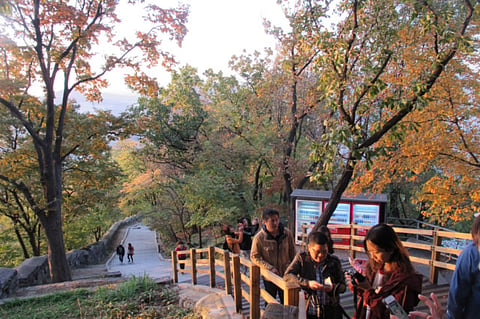Why I dislike the leaf blowers
Leaves that fall across every inch of this suburbia are so much prettier

In autumn, when light gleams on the red dogwood berries and the blue arrowwood berries and the purple beautyberries; on the last of the many-coloured zinnias and the last of the yellow marigolds and the last of the white snakeroot flowers; on the shining hair of babies in strollers and the shining ponytails of young mothers and the tender, shining heads of old men walking dogs — into the midst of all this beauty, the kind of beauty that makes despair seem like only a figment of the midnight imagination, the monsters arrive.
They come in a deafening, surging swarm, blasting from lawn to lawn and filling the air with the stench of gasoline and death. I would call them mechanical locusts, descending upon every patch of gold in the neighbourhood the way the grasshoppers of old would arrive, in numbers so great they darkened the sky, to lay bare a cornfield in minutes. But that comparison is unfair to locusts.
Grasshoppers belong here. Gasoline-powered leaf blowers are invaders, the most maddening of all the maddening, environment-destroying tools of the American lawn-care industry.
Nearly everything about how Americans “care” for their lawns is deadly. Pesticides prevent wild flower seeds from germinating and poison the insects that feed songbirds and other wildlife.
Lawnmower blades, set too low, chop into bits the snakes and turtles and baby rabbits that can’t get away in time. Mulch, piled too deep, smothers ground-nesting bees, and often the very plants that mulch is supposed to protect, as well.
But the gasoline-powered leaf blower exists in a category of environmental hell all its own, spewing pollutants — carbon monoxide, smog-forming nitrous oxides, carcinogenic hydrocarbons — into the atmosphere at a literally breathtaking rate.
This particular environmental catastrophe is not news. A 2011 study by Edmunds found that a two-stroke gasoline-powered leaf blower spewed out more pollution than a 6,200-pound Ford F-150 SVT Raptor pickup truck. Jason Kavanagh, the engineering editor at Edmunds at the time, noted that “hydrocarbon emissions from a half-hour of yard work with the two-stroke leaf blower are about the same as a 3,900-mile drive from Texas to Alaska in a Raptor.”
The risks come not only from the noise and the chemical emissions that two-stroke engines produce, but also from the dust they stir up. “That dust can contain pollen, mold, animal faeces, heavy metals and chemicals from herbicides and pesticides,” notes Sara Peach of Yale Climate Connections. All this adds up to increased risk of lung cancer, asthma, cardiovascular disease, premature birth and other life-threatening conditions.
More than 100 cities across the US have already passed regulations to ban or restrict gas-powered leaf blowers. For people committed to their manicured lawns, the good news is that powerful electric and battery-operated leaf blowers now exist, and they are quieter and greener and healthier than gasoline-powered blowers. Their market share is also growing rapidly; electric equipment now represents roughly 44 per cent of lawn-care machinery sales.
But the trouble with leaf blowers isn’t only their pollution-spewing health consequences. It’s also the damage they do to biodiversity. Fallen leaves provide protection for overwintering insects and the egg sacs of others.
Leaf blowers, whether electric or gasoline-powered, dislodge the leaf litter that is so essential to insect life — the insect life that in turn is so essential to birds and other wildlife.
And the leaves that fall across every inch of this wild half acre of suburbia are so much prettier than any unnaturally green lawn beaten into submission by stench-spewing machinery.
All those golden sugar maple leaves hold onto the light, and for weeks it looks as though our whole yard is on fire, even in the rain. Who could be troubled by a blanket made of light? A blanket keeping all the little creatures safe from the cold?
— Margaret Renkl is a contributing opinion writer who covers flora, fauna, politics and culture in the American South.
The New York Times
Sign up for the Daily Briefing
Get the latest news and updates straight to your inbox






